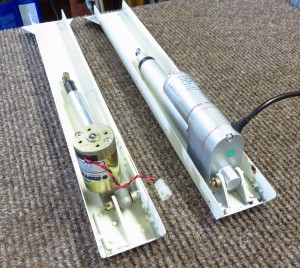We will soon be introducing our new RV Flap Actuator, which for some folks will be a big improvement over their current flap motor.
Although not a direct replacement, only minor modifications are necessary either to an existing installation or if building a new installation. Our Installation & Operating Instructions are available for download and printing here. We found that the installation in our RV-6 was relatively simple. We did order a new flap motor channel from the mothership just to facilitate the changeover, but you could modify the one you have. The majority of the work involves making a couple of new brackets out of 1 1/2 x 1 1/2 x 0.125″ 2024T3 angle. The actuator is a little over an inch longer than the stock one, so you have to adjust for that. We were able to move the attach point back about an inch because the new brackets can be made shorter—and the other 3/8″ or so was adjusted for in the flap links, which you may be able to adjust with the rod ends. In the extreme case, you may have to make up a couple of new links.
We have been operating our RV-6 with 3 different prototypes for over 6 months now with great success. The nice thing about this actuator is that it stops completely at either extreme of the stroke. So when you get to full flaps, the motor stops—likewise for flaps up. The motor does not keep running, so it is not necessary to have a spring-loaded switch to operate the flaps. The other nice feature is that the actuator contains a position-sensing potentiometer inside the housing so that you can wire directly to a flap indicator or to your EFIS flap gauge.
We had these actuators made for us by a very reputable manufacturer to our specification. We have every confidence that these units are plenty robust and should last a very long time. We feel that this actuator will solve the “migrating grease” problem that some of the stock units experienced. It is also not necessary to do the safety wire bulletin required in the stock units because the rod end does not rotate.
About the only negative we found was that these units are slightly longer (about 1.375″) and slightly heavier (about 9 ounces).
We do not have experience with its installation in any of the other RVs besides the RV-6, so your mileage may vary. We would appreciate hearing from any customers who install our actuator in some of the other RVs so that we can relay your experiences to others. Here is a photo we took during the modification of our RV that shows the two units side by side.
And finally, compare the price of this actuator with the $460 cost of the stock actuator!

